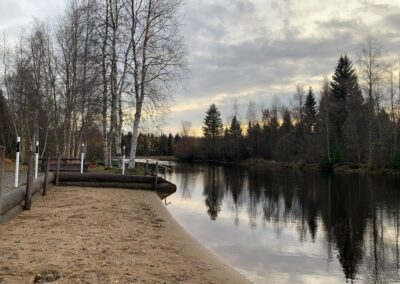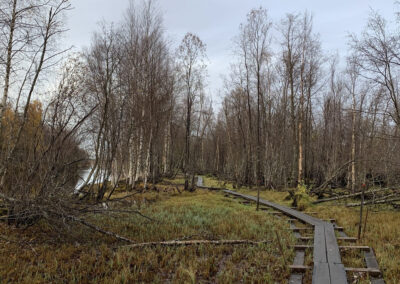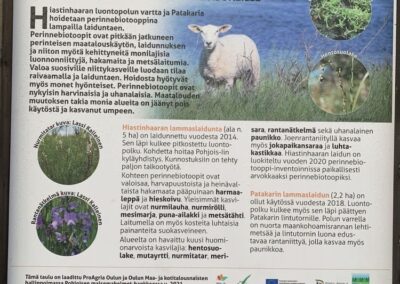Ii municipality

Basic info
Country:
Area:
Population:
Density:
Summary:
References:
Keywords
Gallery
Revitalizing landscapes, enriching community, and enhancing biodiversity: A rural symphony of sustainability.
Issues Addressed
The Hiastinhaara area, a valuable site of traditional biotopes, faced neglect and decay. These unique ecosystems were threatened by agricultural changes and disuse. Additionally, a nationally important landscape, historic nature trail and bird-watching tower had fallen into disrepair. The local municipality recognised the value of this natural heritage and sought to revitalise the area, restoring the trail and tower while preserving the delicate balance of the traditional biotopes.
Approaches and Solutions
The success of the Hiastinhaara project hinged on a collaborative approach involving multiple stakeholders. The Ii municipality took the lead in coordinating the overall project, working closely with the North Ii Village Association, which initiated the pasture restoration in 2014. This grassroots beginning set the stage for broader community involvement.
Local farm-land owners played a crucial role by providing land for grazing, demonstrating the project’s reliance on public-private partnerships. Pro Agria, an agricultural advisory organization, offered valuable expertise in sustainable farming practices, ensuring that the grazing methods aligned with conservation goals.
Actors and Stakeholders
The success of the Hiastinhaara project hinged on a collaborative approach involving multiple stakeholders. The Ii municipality took the lead in coordinating the overall project, working closely with the North Ii Village Association, which initiated the pasture restoration in 2014. This grassroots beginning set the stage for broader community involvement. Local farmland owners played a crucial role by providing land for grazing, demonstrating the project’s reliance on public-private partnerships. Pro Agria, an agricultural advisory organization, offered valuable expertise in sustainable farming practices, ensuring that the grazing methods aligned with conservation goals. The project’s cornerstone was the introduction of contract sheep grazing as a long-term, sustainable landscape maintenance tool. This innovative approach not only addressed the overgrowth issue but also created a unique attraction for visitors. The municipality coordinated the renovation of the nature trail and bird tower in 2017, enhancing accessibility and visitor experience. As the project evolved, its scope expanded. The North Ii Village Association extended the pasture to Patakari in 2018, and by 2022, more areas were opened for contract grazing. This gradual expansion allowed for adaptive management, incorporating lessons learned at each stage.
Challenges and Opportunities
The Hiastinhaara area, known for its rich biodiversity and cultural significance, faced several challenges. Neglect threatened unique ecosystems, a nationally important landscape deteriorated, and a historic nature trail and bird-watching tower fell into disrepair. The local municipality recognised the urgent need to revitalize this natural heritage while maintaining its delicate ecological balance.
Outcomes and Lessons Learnt
The Hiastinhaara project yielded multifaceted benefits. Biodiversity flourished, with the discovery of endangered plant species and improved habitats for various animals, including the threatened ptarmigan. The landscape transformation from overgrown areas to traditional open vistas enhanced the region’s visual appeal and cultural significance. The project’s impact extended beyond ecological benefits. It catalysed community engagement, strengthening ties between local authorities, farmers, and residents. The sheep pastures and restored biotopes created a unique attraction, boosting local tourism potential and demonstrating how conservation efforts can align with economic development.
The Hiastinhaara project offers valuable insights for other rural municipalities. It highlights the importance of an integrated approach that combines ecological restoration with cultural preservation and tourism development. The success of using sheep grazing as a maintenance tool proved both effective and economically viable, providing a model for sustainable land management. Moreover, the project demonstrates how preserving natural areas can provide multiple ecosystem services, from biodiversity conservation to recreational opportunities. It aligns with Finland’s broader commitment to nature conservation, as evidenced by its extensive network of protected areas and participation in the Natura 2000 program.
Selected major projects and awards
- North Ostrobothnia Landscape of the Year award in 2020.
- Suomen paras maisemahanke 2022
- Anita Sievänen received the 2020 Municipal Environmental Award has been awarded to Anita Sievänen from North Ii, who, together with the village association, has steered Hiastinhaara into one of Ii’s most popular local nature destinations and has activated the residents of the municipality towards nature, the source of well-being.



